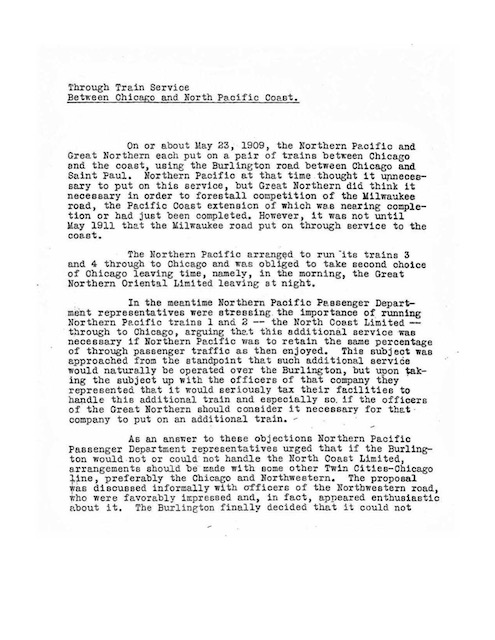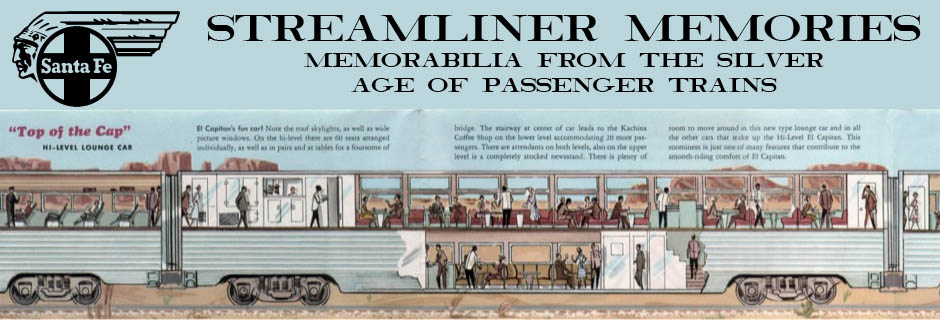Seven years ago, I noted the strange fact that the North Coast Limited went over the Chicago & North Western between 1911 and 1918. This is peculiar because Northern Pacific owned almost half of the Burlington and for most of history routed its trains over the Burlington between St. Paul and Chicago.
 Click image to download a 1.1-MB PDF of this five-page document.
Click image to download a 1.1-MB PDF of this five-page document.
A Northern Pacific historian named James Dick found the answer in the NP archives at the Minnesota History Center and graciously allowed me to post it here. Specifically, he found a three-page memo written in 1926 presenting the recollections of an NP employee — I can’t read his name, which appears to be just initials.
According to the memo, NP’s tie with C&NW came about because the Great Northern wanted to preempt the St. Paul Road’s imminent start of passenger train service from Chicago to Seattle (the St. Paul Road is now called the Milwaukee Road). GN decided, and urged NP to agree, to run its own Seattle-St. Paul passenger trains into Chicago as well. Since the two railroads co-owned the Burlington, they routed them on the Burlington starting on May 23, 1909. To serve as many people as possible, GN scheduled its train to depart Chicago in the evening and asked or, apparently, demanded that NP schedule its train to depart Chicago in the morning.
GN’s entry into the Chicago-Seattle run was its premiere train, the Oriental Limited. NP’s premiere train, the North Coast Limited, operated on a schedule similar to the Oriental, so it initially sent its secondary train, #3 & 4, to Chicago, calling it the Northern Pacific Express.
The St. Paul didn’t get their Chicago-Seattle train running until 1911, but when it did NP officials soon realized that the railway would have to send its premiere train to Chicago as well. But here it ran into a bottleneck: Burlington said that it didn’t have the facilities to handle another overnight train between Chicago and St. Paul. At the time, most railroads relied on train orders to protect their trains from collisions, which greatly limited their capacity. As of 1906, fewer than 7,000 miles of the nation’s 195,000 miles of rail routes used automatic block signaling, which greatly increased a line’s capacity.
The Chicago & North Western offered to handle the North Coast Limited if the Burlington would not. The memo doesn’t say whether this was because the C&NW had more capacity or fewer trains. NP’s president, Howard Elliot, went to James J. Hill, who didn’t own much of the NP himself but had a lot of influence over it, and asked what he thought of running an NP train over the C&NW. Hill said he didn’t mind if the Burlington didn’t mind.
So, as indicated by a two-page memo dated December 14, 1911 (also found by historian Dick at the Minnesota History Center and included in the above PDF), NP began running the North Coast Limited to Chicago over the C&NW. The train went over C&NW’s Milwaukee line, giving North Coast Limited passengers the opportunity to go to or from that city (which they would not have on the Burlington).
This arrangement remained in place until the United States Railroad Administration (USRA) took over the railroads in 1918 because the government didn’t believe the railroads could handle World War I traffic. The USRA decided to run all NP trains over the Burlington, and they stayed there after the railroads were returned to private hands after the end of the war.
(As an aside, Franklin Roosevelt wanted to have the federal government take over the railroads again during World War II. He was talked out of it by none other than Ralph Budd, who was president of the Burlington at the time.)
The 1926 memo suggests that NP hoped that, by routing its top passenger train over the C&NW, the latter road would route more freight to the NP. However, it doesn’t say whether this happened. As I mentioned in my previous post about this subject, we do know that six months after the NP-C&NW agreement, UP yanked the freight business it was giving to the C&NW in Omaha and gave it to the Milwaukee Road. It was never officially stated, but it was widely rumored at the time that this was UP punishing C&NW for cooperating with its rivals.
